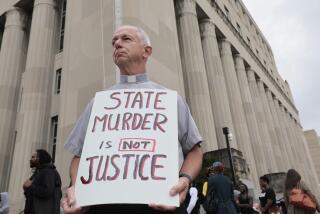PERSPECTIVE ON THE DENNY VERDICTS : The People’s Jury Did Its Job : The critics forget that Williams was convicted for what he did. Justice will be fully served if he does maximum time.
After struggling for two weeks, a multiracial Los Angeles jury agreed that Damian Williams and Henry Watson did not attempt to murder Reginald Denny. Nor, concluded the jury, did they deliberately intend to commit mayhem (to maim), an ancient common-law crime that connotes dismemberment or disfigurement.
Everyone who saw the videotaped beating of Denny understood that a terrible and possibly fatal act had been committed against him. His attackers not only left him bloodied and semiconscious; the videotape also showed one of them--Williams--doing a jubilant dance over Denny’s stricken body. Furthermore, this was, by any reasonable definition, a “hate crime.” African-American motorists drove through the intersection of Florence and Normandie unharmed; white, Asian and Latino drivers were detained, beaten and robbed by angry young black men. Many people who viewed the videotapes--whites and nonwhites, liberals as well as conservatives--reacted with a visceral feeling of outrage at the verdict.
Now that the jury’s judgment is in, people are debating whether it was just and reasonable, whether the prosecutors overcharged, whether the jurors were influenced by the tense racial climate and what it all means about our notions of justice.
The concept of crime includes an act and a state of mind. A videotape shows us what happened better than any eyewitness can. But it cannot tell us why it happened. Williams’ lawyer, Edi M. O. Faal, understood that very well. He knew that to prove attempted murder, the state needed to demonstrate intent to kill. Had Williams used a gun, there would have been little question. But a brick is an uncertain weapon. If Williams wanted to kill, Faal asked the jury, why didn’t he hit Denny again and again, evoking images of Rodney King, who was struck 56 times with a metal police baton. And Faal introduced an expert on riot behavior who suggested how Denny’s assailants were caught up in the hysteria of the crowd.
Besides, Williams didn’t have any motive or prior animus toward Denny; the trucker was a complete stranger. Williams brutalized a man whose only offense was showing a white face.
Could any juror, or any reader of this column, for that matter, confidently conclude, beyond a reasonable doubt, that Williams intended to put Denny to death or disfigure him with a blow by a brick?
Williams had committed a vicious criminal act, but it wasn’t easy for a juror to figure out which section of the California Penal Code he (and Watson) had violated.
The prosecution did not make it easy. The jury was presented with a dozen different charges, and that had to be confusing and frustrating. Yet the prosecutors were on the horns of a dilemma. Surely they knew how difficult it would be to prove attempted murder or aggravated mayhem. But if they chose to file lesser charges, less difficult to prove, there would be an avalanche of criticism. Evidently, they thought that public opinion demanded that they bring the most serious charges and leave it to the jury to decide.
Unfortunately, the news reports emphasizing acquittal on the most serious charges overshadowed the fact that Williams, the brick-thrower, was convicted of a serious felony and several assault charges. The taste of his victory champagne may turn sharply sour after he serves some prison time.
Still, Williams is a lucky man. His success was in avoiding a lifetime in prison, which he would have suffered if his victim had died. But Denny didn’t die, as he might have had he not been rescued by good Samaritans from the African-American community whose interests Williams wrongly thought he was representing. Paradoxically, since Denny didn’t die, a rational jury couldn’t tell whether Williams had really intended to kill him.
The talk shows have been filled with criticism of the jury. These brave citizens who put aside weeks of their lives to represent the rest of us deserve applause; instead they have been castigated as gutless, full of fear, “politically correct.”
The jury is an institution of the people. We have it because we want ordinary and representative citizens to decide such issues as the intentions of a perpetrator. In this case, the jury did its job. Its verdict is simple: The videotape showing the brutal assault on Reginald Denny didn’t prove beyond a reasonable doubt that Damian Williams or Henry Watson intended to murder or disfigure him.
Williams deserves to spend years in prison reflecting on his night of impulsive destruction and wanton brutality. The California Penal Code and the jury have given the judge an opportunity to put him there. Let’s hope he gets the maximum sentence the law allows. Then justice will have been fully served.
More to Read
Sign up for Essential California
The most important California stories and recommendations in your inbox every morning.
You may occasionally receive promotional content from the Los Angeles Times.










